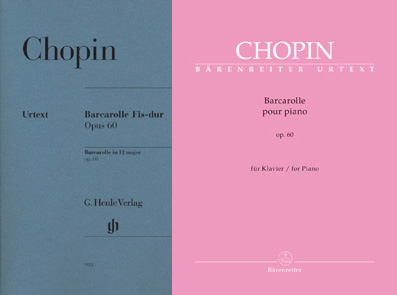 CHOPIN BÃRENREITER URTEXT CHOPIN BÃRENREITER URTEXT
Barcarolle / pour piano / op. 60
Urtext / Herausgegeben / Edited by von Wendelin Bitzan
Fingersatz und Hinweise zur Aufführungspraxis von / Fingering and Notes on Performance Practice by Hardy Rittner
Bärenreiter Kassel - Basel - London - New York - Praha / BA 11831 / © (June) 2020
Our commitment to our readers requires us to take a look at the recent edition of Barcarolle Op. 60. We would have preferred to do without it, but since we had already ignored the edition by Norbert Müllemann (Henle 2012), we decided to partially compare the two editions: Bärenreiter (BR) and Henle (HN).
After the disastrous edition of the Préludes, the famous publishing house Bärenreiter tries again with the Barcarolle, but changes the first makeshift chopinologist, Christoph Flamm, replacing him with a second one, Wendelin Bitzan; however, the piano consultant remains Hardy Rittner. Obviously, we cannot help but call in, where necessary, the Polish national edition by Jan Ekier (2002).
We would like to point out at once that, wanting to get rid of this task as quickly as possible, we will not say all that should be said, but we will pick only some of the most flamboyant flowers, so as to offer some useful information.
The constitution of the text is based on two manuscripts and the three first editions. We have in fact AF, the manuscript used for F (first French edition), and AG, the manuscript used as an antigraph for G (first German edition). The manuscript sent to London, *AE (which Ekier calls [A2]), is presumed lost.
The poor philological expertise of the editors is immediately apparent in the analysis of the relationships between the sources. For example, Ekier claims that the antigraph for G was written by copying the lost manuscript (> E). Which is correct. Müllemann, on the other hand, writes (p. 18): «AF has the greatest amount of corrections. The readings following the corrections of AF recur in AG without corrections. AG was thus presumably copied from AF (or [AE])» (the alternative put in square brackets displays how clear the editor's ideas were!). Bitzan (p. 11) repeats what Müllemann writes, without quoting HN, as usual: «The corrections contained in AF are executed in AG, which leads to the assumption that AF served as the model for AG».
Well, m. 101 incontrovertibly demonstrates that the antigraph for AG was *AE, not AF. So Ekier is right.
On the left you find the transcript of the two manuscripts (the accidentals in angled brackets are an integration of ours), 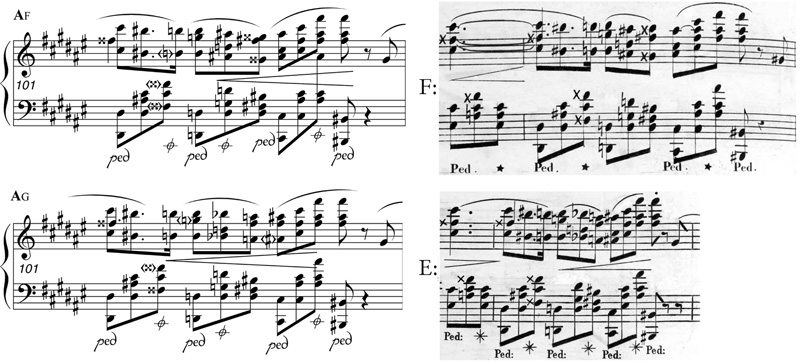 on the right the relevant edition. Besides, the comparison between AF and F allows us to establish that Chopin, while proofreading, made two substantial corrections: (1) he added the ties and (2) he inserted A5 in the third last chord (in Jane Stirling's copy, this A5 appears deleted, but it is a facilitation for the pupil, for whom Chopin wrote some other simplifications: it is certainly not a correction of the text). Moreover, from the comparison between AG and E we can deduce with certainty that *AE already contained the correction of the fourth last chord modified from A#4-F#5-A#5 into A#4-C#5-A#5. This allows us to establish that AG was copied from *AE, before the latter was revised: in other words, AG loses value compared to AF and *AE; which means that the main sources for the constitution of the text are F and E. Concluding with m. 101, we have here a clear variant that both editors ignore: Müllemann prints the text of F, Bitzan that of AF! Ekier, on the contrary, appropriately indicates the variant.
Another example, small but significant. In the commentary on m. 11 Müllemann notes: "In Mikuli third-last-note F# instead of D#", but says nothing else. Is it a variant? Is it a mistake? He does not say that! 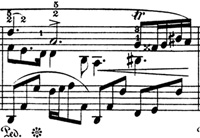 According to Ekier, who does not quote Mikuli, it is a mistake. Bitzan says something more: " F: eighth notes D# (beats 7 and 10) lacking leger lines, which has mistakenly lead to F# in some modern editions". However, to justify the erroneous reading of Mikuli, pupil of Chopin and scrupulous editor of his master's works, a philologist needs something else. The first to accept this presumed variant, moreover modifying it, was Klindworth, who saw it in the Tellefsen edition (the Berlin edition of 1880 edited by Klindworth is a re-edition—not the first edition and not even a second one—of the Moscow edition dated several years earlier; therefore, Rittner, cf. BR p. VI, n. 6, gives an erroneous information). Mikuli was mistakenly convinced that it came from a correction in his fellow's copy. Actually, it was a misreading of Richault's engraver, caused by F's engraver, a bungler indeed. In this case Bitzan saw right, but did not investigate the source of the error.
And now we come to a much more important issue of performance practice: the alleged arpeggiated chords. All modern editors, not excluding Ekier, not having understood that in Chopin the curved line and the vertical squiggle attached to a chord have a different meaning, mix things indiscriminately. The superficiality of the engravers cannot justify the superficiality of the editors, especially if, as in the case of the Barcarolle, there are two autograph manuscripts. Why not respect them? The answer is simple: by obtuseness.
In editors' opinion the alleged arpeggiated chords are in mm. 8, 14, 86, 88, 89, 90, and 107 (in WN and HN also 105, and, only in WN, 109). Well, as incredible as it may seem, in both the mss. there is no trace of a vertical squiggle indicating the arpeggio! In all the cases mentioned Chopin marks a curved line. Since we do not have *AE, we have to rely on E.
 In our three illustrative tables we have arranged the chords as they appear in E (< * AE), AF > F (on the left), and AG > G (below, on the right). We can see that the German engraver alone respects what he sees. The London engraver seems to read now a curved line, now a vertical squiggle; however, if AG is—as we have seen—a copy of * AE, it is likely that he was confused, undecided, or distracted. The Parisian engraver, on the contrary, misuses his will, since he changes all the curved lines into vertical squiggles. We like to note that Brahms, the editor of the 10th volume (containing the Barcarolle) of the first critical edition of Chopin's works published by Breitkopf & Härtel, welcomes F's vertical squiggle only in m. 8, where the autograph at his disposal (AG) did not indicate anything (due to Chopin's oversight), thus proving, indirectly, that he was well aware that curved line and vertical squiggle are not the same thing.
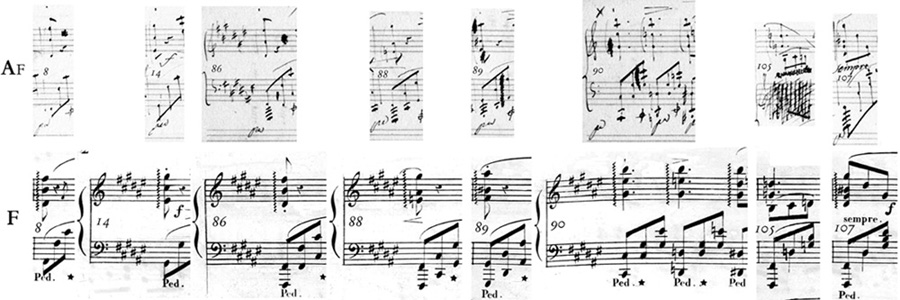
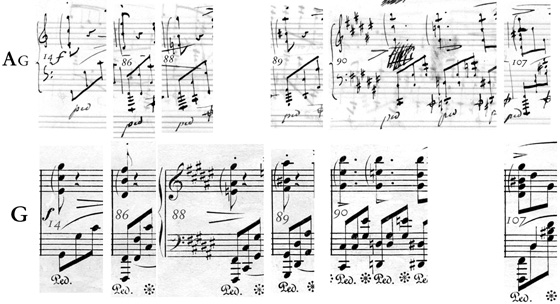
Fortunately, at the end of the Scherzo Op. 54 we have a beautiful series of vertical squiggles that illustrates how Chopin used to write the arpeggio mark, from the most accurate to the most essential.
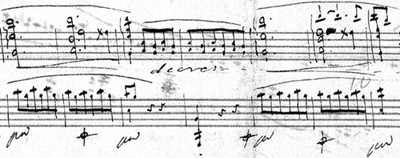 As you can see (mm. 903÷909) even in the most simplified form (m. 909) the line is not clean, but it is diverted more or less in the middle. His curved line, instead, even if light, is drawn by a single pen stroke, without uncertainties.
But what is astonishing is how it is possible that the editors of the Barcarolle have not noticed that it is the composer himself who illustrates how those presumed arpeggiated chords are to be performed. The comparison between mm. 26-86, 28-88, 29-89 and 30-90 is extremely instructive: in the first measure he uses the most explicit form of writing, in the second one the easiest to write. 
Well, about this whole thing nobody said a word. You should think the editors did not even notice the problem. So, on the one hand they have not detected any difference between the curved line and the vertical squiggle, on the other hand—to make up for it—they get lost in such a boring and useless description of the slurs. It seems that their greatest concern is to understand from which note a slur begins and where it ends, thus demonstrating that they have not understood anything of the criterion or principle, according to which Chopin places the slurs. We have already pointed it out elsewhere, but we repeat it once again: in Chopin the slurs do not concern the legato, but the breathing. The case of m. 102 is somehow emblematic: in AG Chopin—who is copying at his desk—marked a routine slur; in AF the breath is placed before the penultimate chord; in the exemplar Dubois the breath is moved before the last one. Here we have a variant, that is, a second possible breathing, but no editor realizes that it is a question of variant: Müllemann chooses AF; Bitzan prefers AG; Ekier opts for the exemplar Dubois. It is the triumph of philology!!! In general, except for a few cases, the apparent differences between the sources are insignificant. But enough of the slurs.
To conclude, as far as the constitution of the text is concerned, apart from some distractions (e.g., BR omits both the staccato-dot in m. 8 and the # to the trill of m. 55, whereas HN in m. 81 puts to the first F# a 1, italics, which is not found in any copy of the pupils), BR is, for practical purposes, almost the copy of HN. Both are much inferior to the Polish national edition, which precedes them by several years! The only real difference is in the fingering: HN prints again the fingering by Hans-Martin Theopold, while BR relies on Hardy Rittner's collaboration. Neither Theopold nor Rittner have any idea what Chopin meant by "new school". We would have liked to make some explanatory comparisons, but we are tired. It will be enough to point out that Mikuli's fingering owes a lot to Klindworth, who often gives—and this applies to Chopin's entire work—good fingering, sometimes brilliant and very Chopin-like. Theopold fingers the obvious. Rittner in some cases proposes original and shareable solutions: for example, in mm. 14-15 and so on, he suggests to entrust the lower note of the octave to the left hand. It is a good suggestion.
Bärenreiter, finally, with the Barcarolle did not produce a disaster like with the Préludes, but certainly an edition as useless as that of Henle, especially in comparison with that edited by Ekier, which, incidentally, is not without defects. Last two remarks: (1) on the second page BR informs the reader that he can access the sources through 'links' provided from time to time: here is a praiseworthy initiative—we said to ourselves—but, when we connected, those 'links' did not work, nor did we receive a reply to our report; (2) the sheet containing pages 3 and 4 is double and folded inside with the nos. 3a and 4a: this is to save a leaf! Horrendous solution!
|
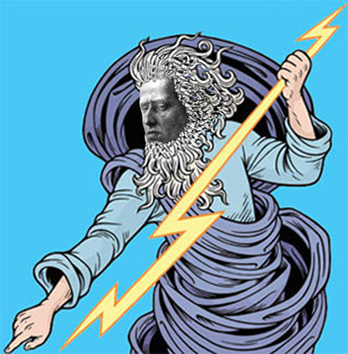
 CHOPIN BÃRENREITER URTEXT
CHOPIN BÃRENREITER URTEXT on the right the relevant edition.
on the right the relevant edition. According to Ekier, who does not quote Mikuli, it is a mistake. Bitzan says something more: "F: eighth notes D# (beats 7 and 10) lacking leger lines, which has mistakenly lead to F# in some modern editions". However, to justify the erroneous reading of Mikuli, pupil of Chopin and scrupulous editor of his master's works, a philologist needs something else. The first to accept this presumed variant, moreover modifying it, was Klindworth, who saw it in the Tellefsen edition (the Berlin edition of 1880 edited by Klindworth is a re-edition—not the first edition and not even a second one—of the Moscow edition dated several years earlier; therefore, Rittner, cf. BR p. VI, n. 6, gives an erroneous information). Mikuli was mistakenly convinced that it came from a correction in his fellow's copy. Actually, it was a misreading of Richault's engraver, caused by F's engraver, a bungler indeed. In this case Bitzan saw right, but did not investigate the source of the error.
According to Ekier, who does not quote Mikuli, it is a mistake. Bitzan says something more: "F: eighth notes D# (beats 7 and 10) lacking leger lines, which has mistakenly lead to F# in some modern editions". However, to justify the erroneous reading of Mikuli, pupil of Chopin and scrupulous editor of his master's works, a philologist needs something else. The first to accept this presumed variant, moreover modifying it, was Klindworth, who saw it in the Tellefsen edition (the Berlin edition of 1880 edited by Klindworth is a re-edition—not the first edition and not even a second one—of the Moscow edition dated several years earlier; therefore, Rittner, cf. BR p. VI, n. 6, gives an erroneous information). Mikuli was mistakenly convinced that it came from a correction in his fellow's copy. Actually, it was a misreading of Richault's engraver, caused by F's engraver, a bungler indeed. In this case Bitzan saw right, but did not investigate the source of the error. In our three illustrative tables we have arranged the chords as they appear in E (< *AE), AF > F (on the left), and AG > G (below, on the right). We can see that the German engraver alone respects what he sees. The London engraver seems to read now a curved line, now a vertical squiggle; however, if AG is—as we have seen—a copy of *AE, it is likely that he was confused, undecided, or distracted. The Parisian engraver, on the contrary, misuses his will, since he changes all the curved lines into vertical squiggles.
In our three illustrative tables we have arranged the chords as they appear in E (< *AE), AF > F (on the left), and AG > G (below, on the right). We can see that the German engraver alone respects what he sees. The London engraver seems to read now a curved line, now a vertical squiggle; however, if AG is—as we have seen—a copy of *AE, it is likely that he was confused, undecided, or distracted. The Parisian engraver, on the contrary, misuses his will, since he changes all the curved lines into vertical squiggles.

 As you can see (mm. 903÷909) even in the most simplified form (m. 909) the line is not clean, but it is diverted more or less in the middle. His curved line, instead, even if light, is drawn by a single pen stroke, without uncertainties.
As you can see (mm. 903÷909) even in the most simplified form (m. 909) the line is not clean, but it is diverted more or less in the middle. His curved line, instead, even if light, is drawn by a single pen stroke, without uncertainties.


